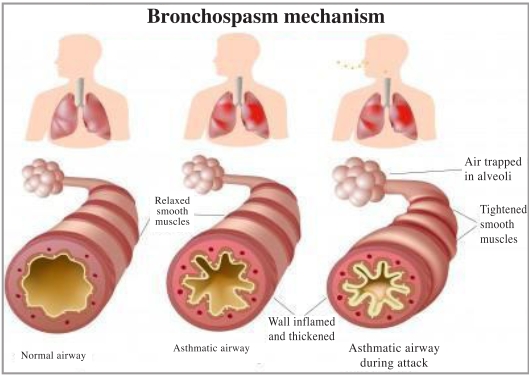ASTHMA

An undiscriminating lung condition
Lung diseases are broadly classified as either obstruction or restrictive in nature, meaning they reduce airflow (obstructive), or they limit air intake (restrictive).
 Asthma
is a common type of obstructive lung condition that affects 7-10
percent of the population, more commonly in male children under the age
of 14 and female adults. There are an estimated 25 million people in
the United States who have asthma, with over $56 billion health-care
dollars spent annually. It affects quality of life and productivity with
59 percent of children who have an attack missing school, and 33
percent of adults who have an attack missing work per year.
Asthma
is a common type of obstructive lung condition that affects 7-10
percent of the population, more commonly in male children under the age
of 14 and female adults. There are an estimated 25 million people in
the United States who have asthma, with over $56 billion health-care
dollars spent annually. It affects quality of life and productivity with
59 percent of children who have an attack missing school, and 33
percent of adults who have an attack missing work per year.
Asthma by definition is a reactive, inflammatory, reversible airway disease. Symptoms can occur episodically or persistently with varying degrees of intensity. Most common manifestations include difficulty breathing, chest pain, cough and/or wheezing. The exact cause of asthma is not well known, but what all patients with asthma have in common are chronic airway inflammation and increased airway sensitivity to various triggers. The strongest identifiable predisposing factor for the development of asthma is a patient who has atopy, which refers to the genetic tendency to develop allergic diseases such as allergic rhinitis (hay fever), eczema and/or asthma. Atopy is most commonly associated with an increased immune response to common allergies such as inhaled or food allergens.
To best understand the disease condition, it can be broken down to the individual physiological components.
Reactive: Frequently, there is a trigger that causes the condition of asthma to flare up and cause symptoms. These triggers may include environmental allergies (dust, pollen, grasses), inhalation of polluted air, tobacco or wood smoke exposure, upper respiratory infections, excitement, exercise or stress, to name a few. Statistics show that less than 50 percent of those with asthma have been taught how to avoid triggers, and of those, less than 50 percent who were taught actively avoid them. These are unfortunate numbers, given one of the ways in which the condition is best treated is to identify and avoid/control the triggers. Active self-management (i.e., controlling triggers) reduces the need for urgent or emergent care visits and hospitalizations and improves perceived control of the condition.
Inflammatory
and reversible: When the lung tissue becomes inflamed, or the
musculature of the walls of the bronchioles goes into spasms, also known
as bronchospasms, symptoms can occur.
As noted on the illustration, with a flare-up, the walls of the airways become inflamed and thereby are thickened, reducing the overall diameter of the airway. With associated constriction of the musculature, additional restriction occurs, further reducing the amount of air that can pass through the airways. Medications are targeted for these specific manifestations in the management and treatment of the condition. Specifically, inhaled corticosteroids (which includes medications like Flovent ®, Qvar ®, Pulmicort ®, Asmanex ® and Arnuity ® ) work to reduce the swelling of the airway tissue and are taken daily independent of symptoms to achieve and maintain control of persistent asthma. Albuterol sulfate (name brand ProAir ®, Proventil ® or Ventolin ® ) or Xopenex ® works to relax the smooth muscles of the airways thereby offering quick relief of symptoms when they occur. It is the narrowing of the airway that results in symptoms of chest tightness, difficulty breathing and can result in wheezing as the air passes through an obstructed passageway. Other combinations of these medications also exist to control the many physiologic activities of this condition.
The diagnosis of asthma is suggested by patient history and/or physical examination, although the diagnosis is strongly supported by spirometry lung function testing in which airflow obstruction (caused by lung swelling or muscle constriction) is identified. If you suspect you may have asthma, seek care from your primary care provider, pulmonary provider or a specialist in asthma, allergy and immunology. Goals of treatment are to reduce the chronic symptoms that interfere with activities of daily living, prevent acute exacerbations, reduce the need for emergency department visit and hospitalizations, and to maintain the best possible pulmonary function. These goals are accomplished through identifying and limiting triggers, managing the airway obstruction through appropriate choice of controller and rescue medications, as well as utilizing overall health maintenance techniques like annual influenza vaccination (flu shot).
Robert Baye, MPAS, PA-C, FAAPA, works as a certified physician assistant in the allergy/asthma practice of Highland Clinic alongside Drs. Whited and Johnson. He routinely evaluates new and established patients to the practice for their conditions related to allergies, asthma and immunology. He can be reached at 798- 4573, and his office is located at 1455 East Bert Kouns Industrial Loop, Suite 106, Shreveport, LA. Visit www. highlandclinic.com/staff/robert-baye-pa-c-mpas-faapa for more information.
